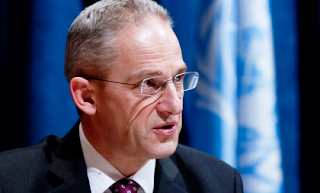The United Nations on Tuesday (12 November 2013) praised the efforts made by the government of the Philippines to respond to the devastation caused by Typhoon Yolanda (international name: Haiyan).
"The Philippine authorities have done a tremendous job in extremely difficult circumstances," said Martin Nesirky, the United Nations spokesperson for the Secretary-General.
Reuters reported that Philippine officials have been overwhelmed by Yolanda, one of the strongest typhoons on record, which tore through the Visays, the central part of the archipelago, on Friday (8 November 2013) and flattened Tacloban, coastal capital of Leyte province where officials had feared 10,000 people died, many drowning in a tsunami-like wall of seawater.
On Tuesday, President Benigno Aquino said the death toll from Haiyan's rampage through the country would closer to 2,000 or 2,500.
Aquino revealed the lower estimated toll after the nuclear-powered aircraft carrier USS George Washington set sail for the Philippines carrying about 5,000 sailors and more than 80 aircraft to accelerate relief efforts. It was joined by four other US Navy ships and should arrive in two to three days, the Pentagon said
Nesirky explained that the geography of the Philippines, with it's numerous islands, makes it difficult to deliver aid in a timely manner.
"People have not received aid in some cases where they desperately need it. Everybody's aware of that. It's a question of being able to marshall the resources you have and to get to the locations you can as quickly as you can. Not easy, but know people are doing the very best that they can," said Nesirky.
International relief efforts have begun to gather pace, with dozens of countries and organizations pledging tens of millions of dollars in aid. UN aid chief Valerie Amos, who has traveled to the Philippines, released $25 million for aid relief on Monday (November 11) from the UN Central Emergency Response Fund.
Rescuers have yet to reach remote parts of the coast, such as Guiuan, a city of 40,000 people that was largely destroyed.
Relief supplies poured into Tacloban along roads flanked with corpses and canyons of debris as the rain fell again. Rescue workers scrambled to reach other towns and villages still cut off, which could reveal the full extent of the casualties and devastation.
Tacloban's government was wiped out by the storm, said Interior Secretary Manuel Roxas. Officials were dead, missing or too overcome with grief to work. Of the city's 293 police officers, only 20 had shown up for duty, he said.
Corazon Soliman, Secretary of the Philippine Department of Social Welfare and Development, said aid had reached a third of Tacloban's 45,000 families. Most of its stores remain closed - either destroyed or shut after widespread looting.
"The Philippine authorities have done a tremendous job in extremely difficult circumstances," said Martin Nesirky, the United Nations spokesperson for the Secretary-General.
Reuters reported that Philippine officials have been overwhelmed by Yolanda, one of the strongest typhoons on record, which tore through the Visays, the central part of the archipelago, on Friday (8 November 2013) and flattened Tacloban, coastal capital of Leyte province where officials had feared 10,000 people died, many drowning in a tsunami-like wall of seawater.
On Tuesday, President Benigno Aquino said the death toll from Haiyan's rampage through the country would closer to 2,000 or 2,500.
Aquino revealed the lower estimated toll after the nuclear-powered aircraft carrier USS George Washington set sail for the Philippines carrying about 5,000 sailors and more than 80 aircraft to accelerate relief efforts. It was joined by four other US Navy ships and should arrive in two to three days, the Pentagon said
Nesirky explained that the geography of the Philippines, with it's numerous islands, makes it difficult to deliver aid in a timely manner.
"People have not received aid in some cases where they desperately need it. Everybody's aware of that. It's a question of being able to marshall the resources you have and to get to the locations you can as quickly as you can. Not easy, but know people are doing the very best that they can," said Nesirky.
International relief efforts have begun to gather pace, with dozens of countries and organizations pledging tens of millions of dollars in aid. UN aid chief Valerie Amos, who has traveled to the Philippines, released $25 million for aid relief on Monday (November 11) from the UN Central Emergency Response Fund.
Rescuers have yet to reach remote parts of the coast, such as Guiuan, a city of 40,000 people that was largely destroyed.
Relief supplies poured into Tacloban along roads flanked with corpses and canyons of debris as the rain fell again. Rescue workers scrambled to reach other towns and villages still cut off, which could reveal the full extent of the casualties and devastation.
Tacloban's government was wiped out by the storm, said Interior Secretary Manuel Roxas. Officials were dead, missing or too overcome with grief to work. Of the city's 293 police officers, only 20 had shown up for duty, he said.
Corazon Soliman, Secretary of the Philippine Department of Social Welfare and Development, said aid had reached a third of Tacloban's 45,000 families. Most of its stores remain closed - either destroyed or shut after widespread looting.
